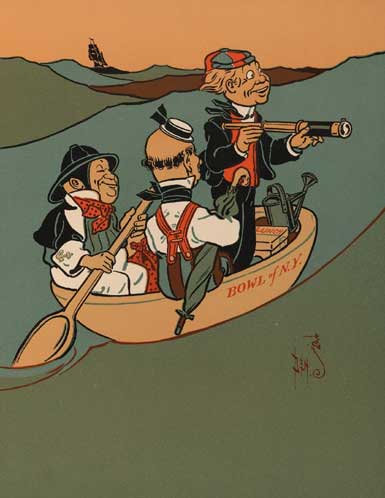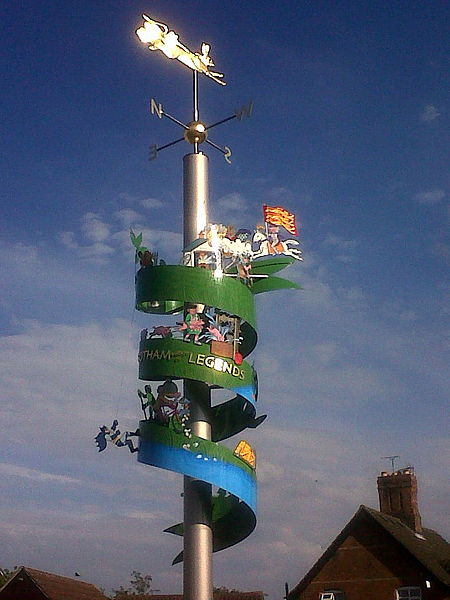The Wise Fools of Gotham – Folk Tales of Nottinghamshire
- Posted in:
- NewsletterArchive
This wonderful addition comes from our Summer 2009 Newsletter:
‘Three wise men of Gotham
Went to sea in a bowl;
And if the bowl had been stronger,
My song would have been longer’
History:
Around the year 1540, an amusing collection of twenty stories were published entitled ‘Certaine Merry Tales of the Mad Men of Gotham’. This book was written by the mysterious ‘A.B. of Phisicke Doctor’.
The pseudonym A.B. was supposed to represent Andrew Borde, an eminent physician and writer who among other things was famous for his wit. In all probability, this was merely a play by the publishers to make people believe that Borde was indeed the author. Interestingly, Borde never denied involvement in the publication.
In subsequent editions, the word ‘mad’ was changed for ‘wise’ and the tales were born.
Although The Wise Men of Gotham is a collection of stories compiled into a single work, it is highly likely that the tales were not the work of one single author, and that many of the stories, perhaps all, existed before 1540. The wise fools of Gotham are first mentioned in the fifteenth century. They appear in the ‘Towneley Mystery Plays’, and one of the later published tales makes an appearance in a manuscript entitled ‘The Wickirk Play’, written between 1425 and 1450.
The Wise Men of Gotham was such a popular publication that the work continued to be re-published almost unchanged up to the end of the nineteenth century. The tales were even exported to America by Washington Irvine who then bestowed the title of ‘Gotham City’ (a city of fools) on his native New York. This in turn turned developed into the Gotham City of Batman.

Above: William Wallace Denslow's illustrations for Three Wise Men of Gotham, from a 1901 edition of Mother Goose. Image: Public Domain.
The tales:
There are two popular versions of the tale. In the first, King John was making his way north towards Nottingham. His chosen route would have taken him directly through land owned by the village of Gotham. At that time, it was believed that wherever the king walked, was from that day a royal highway, with public rights of way. Therefore, to avoid the expense of paying for the upkeep of the new King’s Highway, when King John’s heralds arrived in the village, the good folk of Gotham feigned madness. As madness was thought to be contagious, when this news reached the ears of the King, he quickly changed direction to avoid the village of ‘mad men’.
The second version of the story states that King John was actually considering building a hunting lodge near Gotham. In order to prevent the loss of pasture land and the expense of supporting the royal court, the story continues in the same manner as the first, with the result that the King changes his plans and builds his lodge elsewhere.
There is not enough room here to tell all of the twenty stories of the wise men of Gothams’ strange behaviour, but here is our favourite:
The Cheeses That Ran Away…
There was a man of Gotham who filled a sack with cheeses to sell at the market in Nottingham. He carried the sack of his back, and when he became tired he paused along the way to rest.
Eventually he reached the summit of the last hill before he came to Nottingham Bridge. There he rested, and when he rose to continue his journey, a cheese slipped out of the sack and rolled down the hill towards the bridge.
‘Ah! Mr Cheese,’ said the man, ‘so you can run to market alone, can you? I wish I had known that before. It would have saved me the trouble of carrying you. Well, then, if you can go to market alone, so can the other cheeses, and I’ll send them along after you.’ So, he laid down his sack, took out the cheeses, and rolled them all down the hill. As the last one spun down the road, he shouted, ‘I charge you all to meet me at the market-place.’
Some of the cheeses went into one bush, and some went into another bush, but the man did not notice that, and he trudged on cheerfully to the market expecting the cheeses would meet him there.
All day long he loitered about the market. As evening approached, he began to inquire among the other traders if they had seen his cheeses come to the market.
‘Who should bring them?’ asked one of the traders.
‘Nobody,’ replied the man of Gotham, ‘They would bring themselves. They know the way well enough.’
‘Why, then, aren’t they here?’ said the marketman.
‘A plague on them all!’, cried the owner of the cheeses, ‘It has just occurred to me what the trouble is. I did fear, when I saw them start off so fast, that they would run beyond the market, and I’m sure they must now be miles away on the road to York.’ This said, he hired a horse and rode in all haste to York in pursuit of his cheeses.

Above: Gotham Legends wind vane. Image: By John Beniston - Own work, CC BY-SA 4.0
Which Gotham?
The tales Wise Men of Gotham has long been associated with the Gotham of Nottinghamshire. However, there is another Gotham, in Sussex, that also lays claim to the tales. Fortunately, the Sussex Gotham was never a village or even a hamlet. In actuality, it was only a manor in the parish of Hailsham, a fact that any local writer would have been well aware of. Also, early editions of the book actually mention Nottingham market and that the village was on a direct route to York. Furthermore, it clearly states in one of the stories that the villages paid rent to the lordships of Leicester and Chester which is a known historical fact of the Nottinghamshire village.
Nevertheless, it seems that Gotham only became the ‘best known’ village of fools because of the published tales. There are at least 45 other villages in Britain that claim as their own one or more of the Gotham tales. Gotham is unique in that it not only preserves a complete collection of tales but also preserves many of the locations of the stories.
